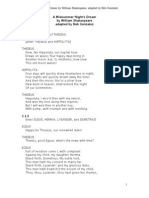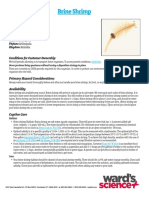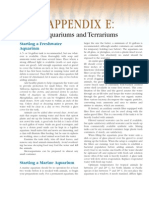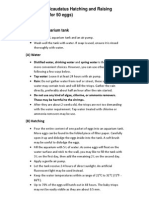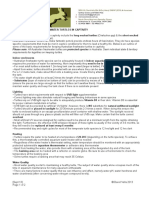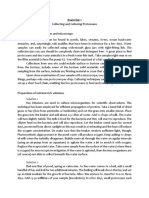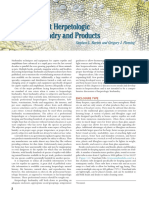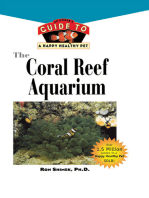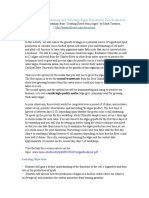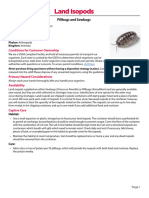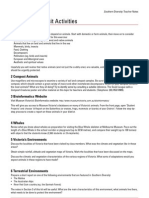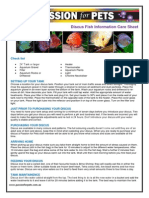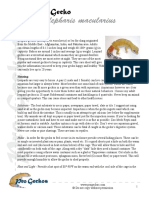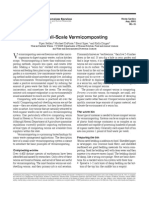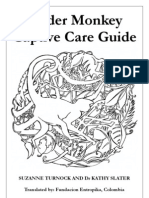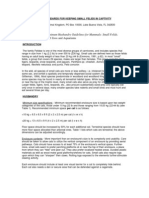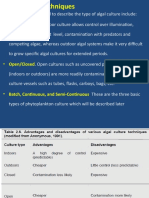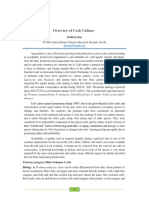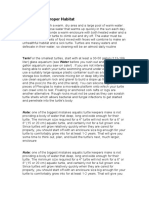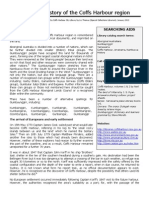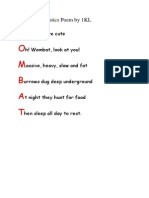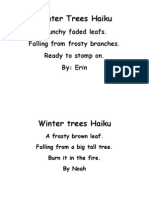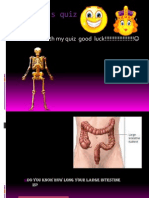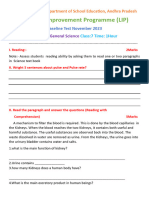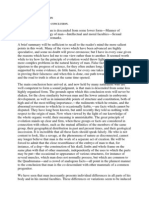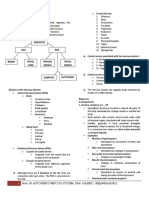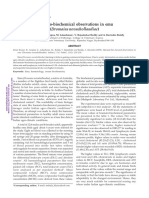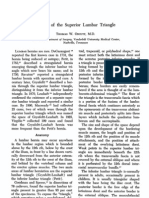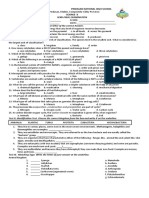Tadpoles in The Classroom NSW DEC
Tadpoles in The Classroom NSW DEC
Uploaded by
Kate BoothCopyright:
Available Formats
Tadpoles in The Classroom NSW DEC
Tadpoles in The Classroom NSW DEC
Uploaded by
Kate BoothOriginal Title
Copyright
Available Formats
Share this document
Did you find this document useful?
Is this content inappropriate?
Copyright:
Available Formats
Tadpoles in The Classroom NSW DEC
Tadpoles in The Classroom NSW DEC
Uploaded by
Kate BoothCopyright:
Available Formats
Animals in schools: Animal welfare guidelines
partb_frog
Frogs and toads (including tadpoles)
Varietal range difference
There are five quite different families of frogs: Tree frogs (family Hylidae) Southern frogs: ground dwelling (family Myobatrachidae) Narrow mouthed frogs (family Microhylidae) True frogs (family Ranidae) True toads (family Bufonidae)
Equipment
The following is required: plastic tub or aquarium. A plastic tub is safer for cleaning. smooth piece of wood angled into tub for tadpoles to emerge onto as they grow legs dip net or aquarium net jug for water changes garbage bin to keep aged water in household bleach pump and air stone.
Approval has been given from Department of Environment and Climate Change for schools to collect up to 20 tadpoles from the same source. When two tadpoles have metamorphosed into frogs, they should be returned, with the remaining tadpoles, to the place from where they were initially collected. If the environment conditions are not suitable for the species being kept, the tadpoles may never metamorphose into frogs. When school holidays are due, schools holding tadpoles must make suitable provisions for daily monitoring during these periods. If daily monitoring is not available, then all the tadpoles should be returned to the place from where they were originally collected. If, after six months, the tadpoles have still not metamorphosed into frogs, the tadpoles should be returned to the place from where they were initially collected.
www.schools.nsw.edu.au/animalsinschools/index.htm
Setting up the environment
Fill a garbage bin with tap water. The water needs to be aged for 24 hours to allow the chlorine to evaporate before adding it to the aquarium. Prepare the tub or aquarium by washing it out with a solution of one part bleach to five parts water. Rinse it thoroughly as tadpoles are very susceptible to chemicals. Place the tub on a flat solid surface, out of direct sunlight. If an air stone is used, a power point, near and above the tanks position, is required.
Schools Animal Care and Ethics Committee
October 2009
1 of 3 pages
Animals in schools: Animal welfare guidelines
Fill the tank with the previously aged water. Tadpoles are poikilothermic, that is, the temperature of the environment determines their body temperature. Ensure the tub maintains a temperature range of 1822C.
partb_frog
environmental conditions and inadequate nutrition can make tadpoles sick. To keep the tadpoles healthy, maintain good water quality and feed them appropriate foods. Bacteria and fungus can also affect tadpoles. The volume of water that tadpoles have access to can affect their growth rate. Do not overcrowd the tadpoles. Keep a daily monitoring chart. Check off daily water changes, feeding and any comments about the behaviour of the animals. As the tadpoles develop legs, their gills recede and they are then unable to breathe under water. At this stage, the tadpoles need areas where they can sit above the water line.
Collecting tadpoles
Ensure that the housing is ready before collecting tadpoles. A maximum of 20 tadpoles only can be taken from one body of water. Do not collect tadpoles from different sites as this could cause disease contamination. Tadpoles must not be collected from a National Park. It is important that all equipment used to catch and carry tadpoles is either new or disinfected prior to use.
Release of tadpoles and frogs
When two tadpoles have metamorphosed into frogs, they should be returned, with the remaining tadpoles, to the exact place from where they were initially collected. Transport the animals in new or disinfected containers.
How to care for tadpoles
Maintaining the environment
Change 3050% of the water daily. The easiest way to do this is to mark, on the side of the tub, a line showing 5070 % of the water remaining in the tub. To ensure that tadpoles are not inadvertently caught in the jug, place the dip net across the mouth of the jug. Add a bleach solution of one part bleach to five parts water to the removed water, prior to disposal. Pour the water down a toilet bowl and not on to the ground or down a sink. Refill the tank with aged water from the garbage bin then top up the garbage bin to age more water for the next day.
Suggested resources
Web sites
Australian and New Zealand Council for the Care of Animals in Research and Teaching (ANZCCART) www.adelaide.edu.au/ANZCCART Environment Australia www.ea.gov.au/biodiversity/threatened/ Frog Census in South Australia www.epa.sa.gov.au\frogcensus Frog and Tadpole Study Group of NSW Inc. www.FATS.org.au NSW Department of Environment, Climate Change and Water www.environment.nsw.gov.au/wildlifelicences/ FrogKeepersLicence.htm Frogs Australia http://frogsaustralia.net.au/ Amphibian Research Centre http://frogs.org.au/ October 2009
Feeding
Feed the tadpoles once daily. Feed only enough to be eaten within one hour. If there is food left at the end of this time, remove it and feed less the next day. Suitable food includes algae disks, fish flakes or lettuce, which has been boiled or frozen to break down the cells.
Health
Learn about what is normal behaviour for tadpoles and check them daily. Incorrect
2 of 3 pages
www.schools.nsw.edu.au/animalsinschools/index.htm
Animals in schools: Animal welfare guidelines Printed texts
Casey, K. (1995) Attracting Frogs to your Garden, Environbook Publishing. Cogger, H.G. (1996) Reptiles and Amphibians of Australia, Reed, Australia. NSW National Parks and Wildlife Service (2001) Hygiene Protocol for the Control of Disease in Frogs, NPWS, Sydney. NSW National Parks and Wildlife Service (2001) Helping frogs survive: a guide for frog enthusiasts, NPWS, Sydney. Robinson, M. (1994) A field guide to frogs of Australia, Reed, Australia.
partb_frog Contact groups
Frog and Tadpole Study Group of NSW Inc. (FATS) PO Box 296, Rockdale NSW 2216. Email: fatsgroupnsw@hotmail.com NSW North Coast Frog Study Group. Email: frogcrusader@north.net.au
CDs and tapes
David Stewart Nature Sound Frog Calls of the
Greater Sydney Basin, (narrated by Richard Morecroft) (Australian Museum Bookshop)
David Stewart Nature Sound Frog Calls of North Eastern NSW, (also Bird & Mammal Calls), PO Box 1261 Atherton Qld 4883. Email: nemarotu@om.com.au Grigg and Barker Frog Calls of South-Eastern Australia, G. Grigg, Department of Zoology University of Queensland, Queensland 4072 or Australian Museum Bookshop. Littlejohn, M. Calls of Victorian Frogs, Victorian Frog Group, PO Box 424, Brunswick Victoria 3056.
October 2009
www.schools.nsw.edu.au/animalsinschools/index.htm
3 of 3 pages
You might also like
- Holka Polka ScriptDocument65 pagesHolka Polka ScriptNatisolangeCorrea83% (6)
- Midsummer Night's Dream in 90 MinDocument49 pagesMidsummer Night's Dream in 90 MinJRWeinh1991100% (4)
- Gumbaynggirr Dictionary 1Document4 pagesGumbaynggirr Dictionary 1Kate BoothNo ratings yet
- Lab 12 Ecology & PopulationsDocument11 pagesLab 12 Ecology & PopulationsJulie AndersonNo ratings yet
- Macleay River Turtle Care SheetDocument3 pagesMacleay River Turtle Care SheetMaddy Van VelzenNo ratings yet
- Aquarium CleaningDocument3 pagesAquarium CleaningarunsinghhydNo ratings yet
- Punctuation WorksheetsDocument10 pagesPunctuation WorksheetsRehan Sadiq100% (3)
- SeaWorld's Emergency Application To Transport TilikumDocument51 pagesSeaWorld's Emergency Application To Transport TilikumTim ZimmermannNo ratings yet
- Sex Stories Part #1Document25 pagesSex Stories Part #1goudtsri43% (7)
- Brine Shrimp: Conditions For Customer OwnershipDocument2 pagesBrine Shrimp: Conditions For Customer OwnershipAMAL MICHAEL SajiNo ratings yet
- Bullfrogs: Conditions For Customer OwnershipDocument3 pagesBullfrogs: Conditions For Customer OwnershiplobaNo ratings yet
- Bullfrog Frog CultureDocument4 pagesBullfrog Frog CultureRenato NoalNo ratings yet
- SLP - GST HUSBANDRY MANUAL-8 2002 CompleteDocument8 pagesSLP - GST HUSBANDRY MANUAL-8 2002 CompleteEusoj SuarezNo ratings yet
- Turtle AquaticDocument2 pagesTurtle AquaticcursorkkdNo ratings yet
- Acuarios y TerrariosDocument2 pagesAcuarios y TerrariosJordan Andres MasseryNo ratings yet
- 5LS - Hydroponics To Aquaponics FI - Activity Sheet - 1Document8 pages5LS - Hydroponics To Aquaponics FI - Activity Sheet - 1Thenu GananNo ratings yet
- Red Eared Slider Care Feeding Housing Diet and CharacteristicsDocument4 pagesRed Eared Slider Care Feeding Housing Diet and CharacteristicsNilamdeen Mohamed ZamilNo ratings yet
- Exercise Stream EcosystemDocument6 pagesExercise Stream EcosystemJamil B. AsumNo ratings yet
- Grade 1 Animals PlantsDocument20 pagesGrade 1 Animals PlantsLow Jun WenNo ratings yet
- Skink CareDocument3 pagesSkink CarehollystarnashNo ratings yet
- Captive Breeding of Devario PathiranaDocument7 pagesCaptive Breeding of Devario Pathirana-Madusha Umayanga-No ratings yet
- Triops Longicaudatus Hatching Instruction V2Document2 pagesTriops Longicaudatus Hatching Instruction V2Melissa SumNo ratings yet
- Brachionus Rotifers Are 200-350 MM Holoplankton, Which Means They Are PermanentDocument5 pagesBrachionus Rotifers Are 200-350 MM Holoplankton, Which Means They Are PermanentBalaji Prasanna KumarNo ratings yet
- PetCo Iguana Care SheetDocument2 pagesPetCo Iguana Care Sheetmicrosoft_userNo ratings yet
- Rock Pool Food Web HomeworkDocument5 pagesRock Pool Food Web Homeworkafetmvbwm100% (1)
- Last YearDocument11 pagesLast YearBattlecruiser ScharnhorstNo ratings yet
- How To Raise Juvenile Discus by Willie LohDocument3 pagesHow To Raise Juvenile Discus by Willie Lohjim_corbet1211No ratings yet
- Water Quality of Turtle 01Document2 pagesWater Quality of Turtle 01Lyssandra FerreiraNo ratings yet
- Exercise 1: Collecting and Culturing ProtozoansDocument2 pagesExercise 1: Collecting and Culturing ProtozoansRegine Pearl RadoNo ratings yet
- Current Herpetologic Husbandry and ProductsDocument11 pagesCurrent Herpetologic Husbandry and ProductsChecko LatteNo ratings yet
- Indonesian Blue Tongue Skink PDFDocument4 pagesIndonesian Blue Tongue Skink PDFSabitha JoachimNo ratings yet
- Introduction To The Cyanobacteria: Architects of Earth's AtmosphereDocument5 pagesIntroduction To The Cyanobacteria: Architects of Earth's Atmospherekha_yenNo ratings yet
- The Coral Reef Aquarium: An Owner's Guide to a Happy Healthy FishFrom EverandThe Coral Reef Aquarium: An Owner's Guide to a Happy Healthy FishRating: 3 out of 5 stars3/5 (1)
- Maximizing and Collecting Algae Biomass For Fuel ProductionDocument5 pagesMaximizing and Collecting Algae Biomass For Fuel ProductionLuis LopezNo ratings yet
- A Call For Change Final English 2010Document7 pagesA Call For Change Final English 2010api-252591504No ratings yet
- Wards Land Isopods LMCSDocument2 pagesWards Land Isopods LMCSppoopman2No ratings yet
- k0202 17Document4 pagesk0202 17bondamaster360No ratings yet
- Bearded DragonDocument2 pagesBearded Dragonapi-202831082No ratings yet
- A Call For Change Final English 2010Document7 pagesA Call For Change Final English 2010api-242446247No ratings yet
- Pre and Post Visit Activities: 1 Animals Are Our Friends!Document9 pagesPre and Post Visit Activities: 1 Animals Are Our Friends!Karthi KeyanNo ratings yet
- Discus Care SheetDocument3 pagesDiscus Care SheetthinkhadleyNo ratings yet
- Eublepharis Macularius: Leopard GeckoDocument5 pagesEublepharis Macularius: Leopard GeckoVictor Isaac Perez soteloNo ratings yet
- VermicompostingDocument4 pagesVermicompostingmobyelectraNo ratings yet
- Spider Monkey CareDocument17 pagesSpider Monkey CaremiamiyoderNo ratings yet
- A Guide To Keeping Tadpoles: Caring For Pond-Dwelling SpeciesDocument3 pagesA Guide To Keeping Tadpoles: Caring For Pond-Dwelling Speciesnightowl345No ratings yet
- Fisheries and Oceans CanadaDocument23 pagesFisheries and Oceans Canadasrindra_tnNo ratings yet
- Lake Study 102Document9 pagesLake Study 102api-547901489No ratings yet
- CainongLab Activity 1 1Document6 pagesCainongLab Activity 1 1John Carlo MacalagayNo ratings yet
- HatcheryDocument4 pagesHatcheryလက္ ေဆာင္No ratings yet
- Zoo Standards For Keeping Small Felids in CaptivityDocument6 pagesZoo Standards For Keeping Small Felids in CaptivityKai KhanNo ratings yet
- Diatom: SeaweedDocument3 pagesDiatom: SeaweedZzaiRraNo ratings yet
- Care For A Gray Tree FrogDocument9 pagesCare For A Gray Tree FrogGerald RagotNo ratings yet
- Raising and Production of CatfishDocument6 pagesRaising and Production of CatfishRylNo ratings yet
- Giant African Land SnailsDocument2 pagesGiant African Land Snailsconquester rhanmiaNo ratings yet
- 5.6 Settlement: First, Pediveligers Are Allowed To Settle and Metamorphose Into PostDocument5 pages5.6 Settlement: First, Pediveligers Are Allowed To Settle and Metamorphose Into PostgerzonNo ratings yet
- Worms Can Recycle Your Garbage-1 1996Document6 pagesWorms Can Recycle Your Garbage-1 1996soulshineta2No ratings yet
- Indoor/OutdoorDocument48 pagesIndoor/OutdoorAnonymous sVheFhq9PNo ratings yet
- A Research On Photoperiod of Crops Grown in Raft-AquaponicsDocument79 pagesA Research On Photoperiod of Crops Grown in Raft-AquaponicsAllain LabraNo ratings yet
- An Online Management Guide, Is Designed To Provide The Recommended Practices To SuccessfullyDocument76 pagesAn Online Management Guide, Is Designed To Provide The Recommended Practices To Successfullyleve5maxxNo ratings yet
- A.ayesathul Barhana (Isolation of Algae From Soil and Water) - 1st MSC MicrobiologDocument20 pagesA.ayesathul Barhana (Isolation of Algae From Soil and Water) - 1st MSC MicrobiologhatijabanuNo ratings yet
- Ajayiand Okoh 2014 JFEApublDocument6 pagesAjayiand Okoh 2014 JFEApublglendelcarla17No ratings yet
- Josileen Jose - 2023 - Crab Culture - Course Manual Winter School On Mariculture TechnologiesDocument12 pagesJosileen Jose - 2023 - Crab Culture - Course Manual Winter School On Mariculture TechnologiesTriana DewiNo ratings yet
- Creating The Proper Habitat: Tankfor The Smallest Turtles, Start With at Least A 30-50 Gallon (113-189Document8 pagesCreating The Proper Habitat: Tankfor The Smallest Turtles, Start With at Least A 30-50 Gallon (113-189Gabrielle RusdenNo ratings yet
- BFAR SpeciesDocument41 pagesBFAR Speciesbieche43No ratings yet
- AXOLOTL CARE GUIDE FOR BEGINNERS: A comprehensive beginner’s guide on how to care, feed, train, groom, health, house axolotl and guidelines to raising theFrom EverandAXOLOTL CARE GUIDE FOR BEGINNERS: A comprehensive beginner’s guide on how to care, feed, train, groom, health, house axolotl and guidelines to raising theNo ratings yet
- Where I'm FromDocument2 pagesWhere I'm FromKate BoothNo ratings yet
- Aboriginal History of The Coffs Harbour RegionDocument16 pagesAboriginal History of The Coffs Harbour RegionKate BoothNo ratings yet
- Wombat Acrostics Poem by 1KLDocument1 pageWombat Acrostics Poem by 1KLKate BoothNo ratings yet
- Winter Trees HaikuDocument5 pagesWinter Trees HaikuKate BoothNo ratings yet
- Trivia Night FundraiserDocument1 pageTrivia Night FundraiserKate BoothNo ratings yet
- Hatchet Virtual World ProjectDocument2 pagesHatchet Virtual World ProjectKate BoothNo ratings yet
- Caitlyn's QuizDocument13 pagesCaitlyn's QuizKate BoothNo ratings yet
- Illustrated Rights of The ChildDocument15 pagesIllustrated Rights of The ChildKate BoothNo ratings yet
- Vertebrates DEC LessonsDocument18 pagesVertebrates DEC LessonsKate BoothNo ratings yet
- The Coiled Serpent OK PDFDocument252 pagesThe Coiled Serpent OK PDFAbdullah Shahab50% (2)
- Psych Unit 5 Study GuideDocument13 pagesPsych Unit 5 Study GuideLauren ThompsonNo ratings yet
- Examples of Superior Examples of Inferior: PlanesDocument2 pagesExamples of Superior Examples of Inferior: PlanesDorothy MaglenteNo ratings yet
- Soal Big 1 22-23Document2 pagesSoal Big 1 22-23Nike DellaNo ratings yet
- Perubahan Sifat Organoleptik Tahu Selama Penyimpanan Pada Suhu KamarDocument14 pagesPerubahan Sifat Organoleptik Tahu Selama Penyimpanan Pada Suhu KamarZona PanganNo ratings yet
- Folk Fantastic FlyerDocument2 pagesFolk Fantastic FlyerMichael AllenNo ratings yet
- 3rd Lecture Morphological Changes During Maturation o Te GameteaDocument25 pages3rd Lecture Morphological Changes During Maturation o Te GameteaHussein Al Saedi100% (1)
- Pedo Tooth AnomaliesDocument5 pagesPedo Tooth Anomalieszuperzilch1676No ratings yet
- Marine Mammal Stranding Response Manual 1st EdDocument106 pagesMarine Mammal Stranding Response Manual 1st EdLokal Lab OngroundNo ratings yet
- Lip Baseline 7 Science-1Document3 pagesLip Baseline 7 Science-1bgodabaNo ratings yet
- Descent of ManDocument14 pagesDescent of ManberrakkibarNo ratings yet
- 338 Pasture and Fodder HusbandryDocument5 pages338 Pasture and Fodder HusbandryZul FazleyyNo ratings yet
- Poriferans ForDocument53 pagesPoriferans ForFilmar Urmanita JoseNo ratings yet
- Insectopia CompendiumDocument53 pagesInsectopia Compendiumnaruto hyuga67% (3)
- Written Test 4Document4 pagesWritten Test 4Nguyễn Ngọc Thiên TúNo ratings yet
- Argument Essay Rough DraftDocument5 pagesArgument Essay Rough Draftapi-527451033No ratings yet
- Unlock Supplementary Materials BookletDocument187 pagesUnlock Supplementary Materials BookletIbrahim Erdem AtilaNo ratings yet
- Autonomic Nervous System - Part 1Document8 pagesAutonomic Nervous System - Part 1karageeNo ratings yet
- Haemato-Biochemical Observations in Emu PDFDocument2 pagesHaemato-Biochemical Observations in Emu PDFMekala LakshmanNo ratings yet
- Petit TriangleDocument4 pagesPetit TriangleSlim SaaryNo ratings yet
- DL Paris ENG1 2Document4 pagesDL Paris ENG1 2Laurie Yabs100% (1)
- Internal Pelvic Floor Self-Massage GuideDocument11 pagesInternal Pelvic Floor Self-Massage GuideArman Ul NasarNo ratings yet
- Science 8 4TH QuarterDocument2 pagesScience 8 4TH Quarterralph remultaNo ratings yet
- Muscles of MasticationDocument18 pagesMuscles of MasticationgauravNo ratings yet
- Young Robin Hood by Fenn, George Manville, 1831-1909Document44 pagesYoung Robin Hood by Fenn, George Manville, 1831-1909Gutenberg.orgNo ratings yet

